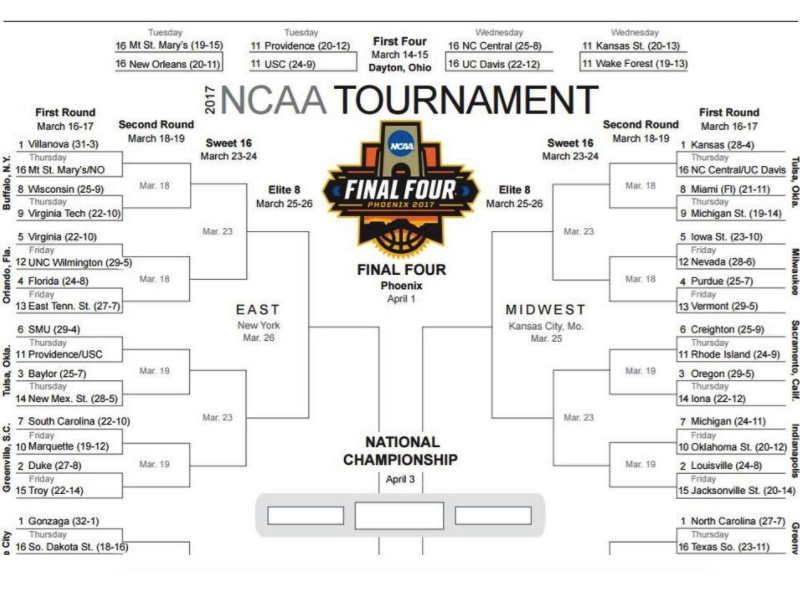It’s March Madness season!!! How might you use math to predict the winner?
Try an easier challenge. If there are 4 teams = 3 games
A-B and C-D and winner of AB and CD play to get a winner.
Game one (2 choices) Game two (2 choices) and Game three (2 choices)
2*2*2=8 possibilities so 1/8 chances to pick the winner.

Since there are 64 teams in the tournament, but you have to correctly predict who will win 63 games, since the eventual champion never loses. As one team loses and one team wins each game, you can then calculate two to the 63rd power, which is 9,223,372,036,854,775,808. Math! 9 quintillion but if you know more factoids of NCAA then you might do better! Good luck!
Some Factoid from http://bracketodds.cs.illinois.edu/BI.html
Some interesting factoids that may help you set your Final Four:
The odds against one or more No. 16 seeds reaching the Final Four is 535 to 1.
The odds against one or more No. 15 or No. 16 seeds reaching the Final Four is 209 to 1.
The odds against one or more No. 14, No. 15, or No. 16 seeds reaching the Final Four is 107 to 1.
The odds against one or more No. 13 through No. 16 seeds reaching the Final Four is 61 to 1.
The odds against one or more No. 12 through No. 16 seeds reaching the Final Four is 36 to 1.
The odds against one or more No. 11 through No. 16 seeds reaching the Final Four is 22 to 1. This has happened three times over the past 32 tournaments (1986, 2006, 2011).
The odds against one or more No. 10 through No. 16 seeds reaching the Final Four is 13 to 1.
This has happened four times over the past 32 tournaments (1986, 2006, 2011, 2016).
The odds against only teams seeded No. 3 or lower (worse) reaching the Final Four is 34 to 1. This has happened only once over the past 32 tournaments (2011).
The odds against only teams seeded No. 1, No. 2, or No. 3 reaching the Final Four is 2.41 to 1. This has happened 11 times over the past 32 tournaments (1989, 1991, 1993, 1994, 1998, 2001, 2003, 2004, 2007, 2008, 2009).
The odds against only teams seeded No. 1 or No. 2 reaching the Final Four is 7.36 to 1. This has happened 3 times over the past 32 tournaments (1993, 2007, 2008).
The NCAA Division 1 Basketball Championship draws a tremendous amount of attention during March Madness. The tournament has 64 selected teams which play 63 total games. That is
- 32 games in the first round
- 16 games in the second round
- 8 games in the 3rd round
- 4 games in the regional finals
- 2 games in the final four
- the national championship game.
The total number of games is: 32+16+8+4+2+1= 63
In recent years there was a bracket challenge from Warren Buffet offering $1 Billion to the person who could pick the entire bracket correctly. The odds of correctly picking the entire bracket were so small that Warren decided the the promotional opportunity was well worth the risk of the $1 Billion. If you wish to try picking the whole bracket, you can follow along with many of the sports networks and others who have bracket charts posted on-line1 2 and many sites will be following the progress of the tournament closely.
Here’s how the large probability adds up:
You have two choices for each game at each round of the bracket. Because there are two choices, there are 2 to the power of 63 different ways to fill out the bracket with the names of the starting 64 teams.
2 to the power of 63 is = 9,223,372,036,854,775,808 Try it in the equation. we let you see how improbable it is to pick the bracket at each round of the tournament as well.
This means there are more than nine quintillion different combinations you could choose from to fill out the entire bracket.
To put this in perspective, let’s look at this probability compared to the number of people in the United States. There are presently over 320 million people in the united States. So, if everyone of those 320 million were to take a shot at picking the winners of each game in the the bracket, the probability that someone in the U.S. would pick the whole bracket correctly is:
Probability(US)=320,000,000/9,223,372,036,854,775,808 That’s a probability of approximately 3.47 X 10−11. That probability expressed as a decimal is 0.00000000003469447. That is extremely small, even if everyone –every single person in the United States — were to take a shot at completing the NCAA basketball tournament bracket.
Let’s have a math chat! Leave me a response to this math happening.
What do you wonder about? |
|
What do you know or notice? |
|
What information do you need? |
|
What assumptions can you make? |
|
What math will you use to solve the problem? |
